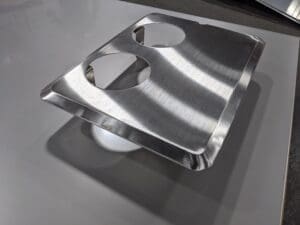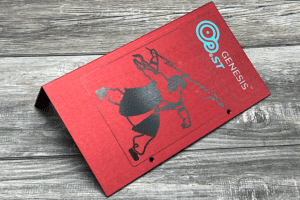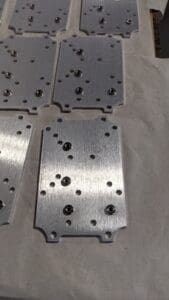Last updated on May 27th, 2025 at 08:21 am
At Approved Sheet Metal, we have extensive experience fabricating high-precision sheet metal components and assemblies for aerospace industry customers.
Whether you’re seeking quick-turn prototypes or low-volume productions, ASM works closely with engineers to ensure every aerospace part adheres to the field’s stringent requirements. When you need aerospace fabrications fast, ASM gets your project across the finish line.
Could ASM be the right collaborative partner for your aerospace parts? Keep reading to find out!
Table of Contents
- 1 ASM’s Aerospace Customers and Capabilities
- 2 ASM’s Approach to 6 Aerospace Challenges
- 3 CAD File Best Practices for Aerospace Sheet Metal Fabrication
- 4 Looking for Aerospace Prototypes or Parts? Let’s Talk
- 5 Aerospace Sheet Metal Fab FAQ
- 5.0.1 What industries does Approved Sheet Metal (ASM) specialize in for their sheet metal components and assemblies?
- 5.0.2 How does ASM ensure the quality and precision of their aerospace parts?
- 5.0.3 What materials does ASM use for fabricating aerospace parts?
- 5.0.4 Can ASM handle tight tolerance requirements for aerospace components?
- 5.0.5 What additional services does ASM provide for aerospace sheet metal fabrication?
ASM’s Aerospace Customers and Capabilities

When time is short, and quality is imperative, the world’s top aerospace companies trust ASM’s dedicated team to fabricate their custom sheet metal parts. You can find our aerospace fabrications in applications by BAE Systems, Bell, Lockheed Martin, Raytheon, Safran, SpaceX, and beyond.
Engineers often struggle to find an ITAR-registered, ISO 9001:2015 certified fabrication shop that can meet their needs for aerospace laser cutting, engraving, forming, hardware insertion, welding, assembly, and finishing. When you work with ASM, you’ll receive top-rated services for flat parts, bent brackets, welded enclosures, assemblies, and so much more.
ASM’s Approach to 6 Aerospace Challenges
Sheet metal fabrication is uniquely complex, and the aerospace industry’s exacting regulations present additional challenges. The good news? ASM is well-equipped to meet every one of those challenges head-on!
1. Part design
Aerospace design engineers aren’t always aware of the elevated costs associated with certain part features—and that’s okay; it’s our job to identify when a design element will require costly custom tooling or expensive specialized processes.
To safeguard our aerospace customers from unnecessary charges and long lead times, we always kickstart part and prototype sheet metal fabrication with an in-depth review of your project.
2. Materials
We fabricate aerospace parts from a variety of metals, including stainless steel, aluminum, and brass. Not all aerospace-grade materials are ideal for all fabrication processes, however.
6061-T6 aluminum is one particularly popular request, but this heat-treated material is extremely hard and prone to scratches, dents, and cracking—especially when bent to 90 degrees or more. When 6061-T6 aluminum is absolutely necessary, we advise engineers to design the part with internal radii equaling at least 2x–3x the material thickness.
5052-H32 is our preferred choice for aluminum fabricated parts. This non-heat-treated alloy enables scratch, dent, and crack-free fabrication with surprisingly smooth surfaces.
The supply chain is another factor to consider when selecting a part’s material. Certain stainless steel selections, for instance, are not readily available and may be difficult to obtain within your timeline or budget.
We’re always happy to suggest alternative materials, but we understand that modifying an aerospace order can be time-consuming at best and impossible at worst. Whatever the scenario, we’ll always communicate our concerns to you right away, offering our guidance so you can make the best decision for your project.
3. Hardware installation
Many aerospace customers utilize the same hardware inserts year after year, calling out that specific hardware on their prints. We’re huge proponents of using what you know works, but challenges arise when your hardware specification comes with a 5,000-piece minimum buy and a 10-week lead time.
If you’d like to modify your print’s hardware callout, we’ll work with you to obtain the proper documentation allowing us to swap unavailable hardware with an alternative that’s faster and more cost-effective to acquire.
4. Precision tolerances
Understandably, engineers commonly design aerospace components with very tight tolerances that cannot be relaxed. If your part’s tolerances are tighter than ASM’s standard sheet metal tolerances, we have highly experienced specialists in-house who can handle the job.
Depending on the part’s requirements, your quote may reflect a longer lead time along with any costs associated with achieving high-precision tolerances. However, the work will be expertly performed and indistinguishable from previous productions of the same part.
5. Finishing solutions
From anodizing to powder coating to plating, ASM offers a range of finishing services in-house and through one of our preferred NADCAP-certified vendors. If you require finishing from a specific vendor, we will gladly manage these services on your behalf, ensuring that the final product meets your specifications.
6. Quality control and inspections
Along with our status as an ITAR-registered, ISO 9001:2015 certified metal fabrication shop, ASM also maintains AS9102 capabilities and offers full certification packages for nearly all materials and finishes.
Occasionally, an aerospace customer will ask us to inspect their parts with our machine shop division’s CMM, but we advise against using a machining inspection tool for sheet metal parts; it’s almost always a direct path to rejected parts. Instead, we’re equipped with a full array of standard inspection equipment for sheet metal manufacturing, including pin gauges, calipers, blocks, and digital height gauges.
CAD File Best Practices for Aerospace Sheet Metal Fabrication
When it comes to fabricating aerospace sheet metal parts quickly and accurately, the quality of your CAD file is just as important as the design itself. A well-prepared 3D model not only reduces back-and-forth but also ensures your part is manufactured exactly as intended—on the first try.
Here are our top CAD file best practices for aerospace fabrication success:
1. Use Native or Neutral File Formats
We accept most major 3D CAD file types, but for best results:
- Preferred:
.SLDPRT(SOLIDWORKS),.STEP,.STP - Acceptable:
.IGS,.DXF(for flat patterns),.DWG - Avoid: Exported 2D drawings as PDFs only—these often lack critical bend or material info
2. Model to Final Material Condition
If you expect post-fabrication finishing (e.g., anodizing, plating), indicate whether your part tolerances are before or after finish. Whenever possible, account for any material thickness changes or radii introduced during forming.
3. Avoid Zero-Thickness Geometry
Models with overlapping or zero-thickness walls are common issues that slow down quoting and manufacturing. Always ensure all sheet metal parts have a defined wall thickness, even in early prototypes.
4. Flattened State Optional—but Helpful
For bent or formed parts, include a flat pattern if you’ve designed one. It speeds up quoting and lets us verify your intended bend allowance. But don’t worry—we can always generate it from your 3D model if needed.
5. Layer and Feature Naming
If you’re submitting multi-part assemblies:
- Clearly name each body or part (e.g., “bracket_LH”, “cover_panel”, “shield_6061”)
- Color-code or separate features by operation, if possible
- Include a simple assembly drawing showing hardware locations or bend directions
6. Call Out Critical Features
Use notes or annotations to highlight:
- Tight tolerance areas
- Special inspection requirements
- Functional surfaces or mating edges
Our engineers review every file in detail, but pointing out what matters most speeds things up—and helps avoid errors down the line.
Want help preparing your model for manufacturing? Just ask—our team is happy to review your design before quoting.
Looking for Aerospace Prototypes or Parts? Let’s Talk
At ASM, we don’t fire up the laser, activate the press brake, or even finalize your quote until we’ve had a detailed discussion about what you want, what you need, and how our team can deliver on every aspect of your part or prototype sheet metal fabrication.
Is your part a prototype? Are you open to a form-fit-function evaluation? Do you truly require precision tolerances? What concessions can you make if we identify opportunities to reduce your cost or lead time?
Our experts can fabricate even the most complex parts, but we’ll only proceed after we’ve completed a full assessment of your project and can tell you confidently that our team is right for your job.
So give us a call, and experience for yourself why ASM’s aerospace customers keep coming back to us for sheet metal manufacturing services!
Ready to get started? Request a quote.




